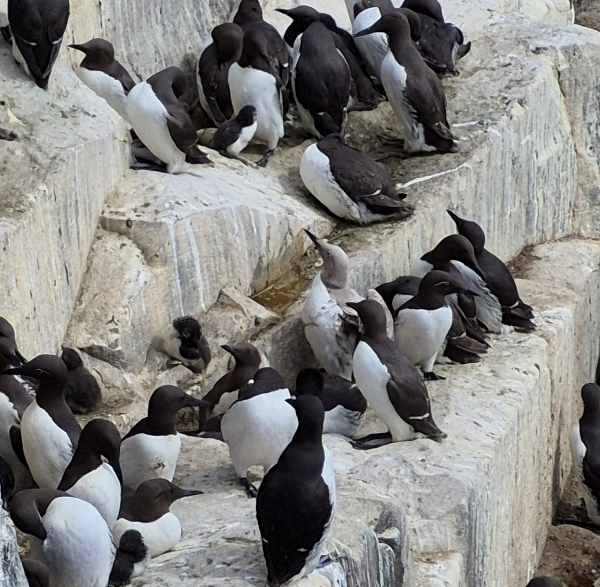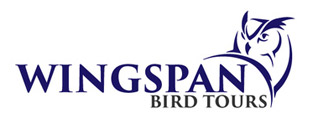
BAMBURGH - SHORESTON POND - SEAHOUSES HARBOUR AND CLIFFS - BOAT CRUISE AROUND THE FARNE ISLES WITH A 1 HOUR LANDING ON INNER FARNE - BUDLE BAY
WEATHER: Short spells of very light rain and at times a little heavier, cloudy all day with some sunny spells. Light to moderate winds. top temp 22C (flet like 11C at times).
The forecast was for rain in the morning and that is what we got, however it was much lighter than expected and of shorter duration. We drove to Bamburgh and then we took the coastal route to Seahouses. The Shoreston roadside Pond looked interesting so we stopped there for a good 45 minutes.

my group looking over to Shoreston Pool
We quickly scanned the pool and found gulls and ducks, Mute Swans and Moorhens. Frances found a single Eurasian Teal whilst the rest of us were watching a variety of passerines. Reed Buntings and Sedge Warblers showed in the sedge around the pool, Skylarks rose above us, Meadow Pipits dashed about chasing one another and Stonechats, Linnets and Goldfinches sat out on bushes. We found several Brown Hares in the cow field beyond the pool.

Eider Duck chicks at Seahouses

female Eiders
At Seahouses we parked the bus for the day and walked to the harbour-front where we scanned the rocks and shoreline on a low tide. Common Eider Ducks were everywhere, mostly females with chicks and the odd male in eclipse-plumage. We also found a Goosanders, a couple of Redshank, Grey Heron and plenty of Gulls.

Goosanders - we had a few sightings of these
Walking around the coastal path towards the cliffs we stopped to scan the shingle for Common Ringed Plovers that were breeding there. We found Curlew, Bar-tailed Godwits and finally two Ringed Plovers. Out to sea wqe watched a pod of Bottle-nosed Dolphins, a few Gannets, more Goosanders and lots more Eiders.

Bottlenose Dolphins
The cliffs play host to a fairly large colony of Kittiwakes with a few pairs of Fulmars, the coastal path runs very close to these birds and we had superb views of them. A bank of earth above the Kittiwakes provides a home for a few pairs of Sand Martins. Rock Pipits flew up delivering their song-flight display and a Common Whitethroat belted out its short, scratchy song from the brambles.

Fulmars on the cliffs at Seahouses
We also logged Gannets, Guillemots and our first Great Black-backed Gulls. A couple of butterfly species were seen too, they were Small Whites and a Red Admiral. On the return journey we had close-up views of a Common Whitethroat in full song and Skylarks dashed about above the fields to our right.

Common Whitethroat doing his best
It was almost lunchtime when we walked back into the centre of Seahouses, we took an hour to find lunch and eat it and then we met up again at the harbour in time to board our boat for the Island Cruise.

Bar-tailed Godwit

Curlew - showing off his balancing skills
As predicted it started to rain just before we boarded the boat and it continued for 15 minutes or so. We were well prepared for this and well protected with our waterproof clothing. Soon it stopped and we were able to enjoy a wonderful cruise around the islands before disembarking at Inner Farne. The boat encircled Staple Island where we watched thousands of birds on the cliffs above us and we enjoyed good close views of them, there were more Guillemots than Puffins, with fewer Razorbills, but all were in great numbers.

a small section of Staple Island

Puffins and Kittiwakes

Tourists looking down at the birds on Inner Farne
At the Outer Farne and the smaller, surrounding islands we watched many Grey Seals, some Gannets actively feeding and as we approached Inner Farne the number of birds in the sky was incredible. Arctic Terns were feeding by the side of the boat, hordes of Auks and Puffins sat on the water whilst Kittiwakes, Fulmars and 5 species of Gull dashed about in all directions and Pat found our first Ruddy Turnstone and then Frances found our first Common Shelduck.

a 'Bridled' Guillemot with its white eyering and white-line behind the eye
Whilst scanning the Guillemots we found several 'Bridled' morphs and on Inner Farne we found a leucistic specimen (almost wholly creamy-white). The Arctic Terns gave us 'what for' as we walked the trails on Inner Farne, they dashed down and pecked your head (or your hat) they particularly disliked blue-coloured hats or anyone who was wearing one.

a very pale leucistic Guillmot can be seen in this picture
Thw whole experience on board and on land was fantastic, everyone really enjoyed the trip and getting very close to the breeding birds ws an exciting experience, I thought it was much better than the last time I came here.

Arctic Terns

Arctic Tern up close

Kittiwakes with chicks

Arctic Tern with chicks

Puffin with sand eels


a European Shag
Back on terra firma we boarded the bus for a smooth ride up to Bamburgh and on to Budle Bay just beyond. The high tide was just receding as we got there, we spent our last hour scanning the huge bay and fast appearing mudflats. Two or three Eurasian Wigeon were a nice surprise, we also saw our first Little Egrets and over 100 Common Shelducks. We also count 72 Curlews, 30+ Oystercatchers, 20 Eider Ducks (some with chicks), Grey Heron and in thre distance many terns alighted on a sandbar, but they were too far off to identify. A couple of Stock Doves flew down on the edge of the mudflats, they were our last new bird of the trip for today.

unexpected - a Wigeon in Budle Bay
It took fifteen minutes to drive back to the hotel and nothing of any great significance jumped out of the bushes, except that Sue and Dee saw a Roe Deer.

Bamburgh Castle from Seahouses - digi-scoped

Lindesfarne Castle from Seahouses - digi-scoped
A delcious dinner was taken at 7pm, we called the birdlog just after, we have notched up 75 species so far.
